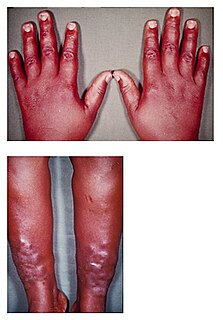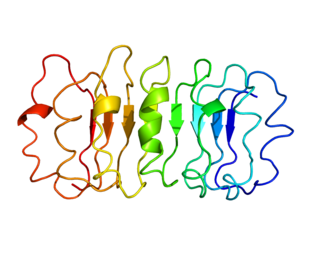Related Research Articles

Graves' disease, also known as toxic diffuse goiter, is an autoimmune disease that affects the thyroid. It frequently results in and is the most common cause of hyperthyroidism. It also often results in an enlarged thyroid. Signs and symptoms of hyperthyroidism may include irritability, muscle weakness, sleeping problems, a fast heartbeat, poor tolerance of heat, diarrhea and unintentional weight loss. Other symptoms may include thickening of the skin on the shins, known as pretibial myxedema, and eye bulging, a condition caused by Graves' ophthalmopathy. About 25 to 80% of people with the condition develop eye problems.
TED may refer to:

In anatomy, the orbit is the cavity or socket of the skull in which the eye and its appendages are situated. "Orbit" can refer to the bony socket, or it can also be used to imply the contents. In the adult human, the volume of the orbit is 30 millilitres, of which the eye occupies 6.5 ml. The orbital contents comprise the eye, the orbital and retrobulbar fascia, extraocular muscles, cranial nerves II, III, IV, V, and VI, blood vessels, fat, the lacrimal gland with its sac and duct, the eyelids, medial and lateral palpebral ligaments, check ligaments, the suspensory ligament, septum, ciliary ganglion and short ciliary nerves.

Exophthalmos is a bulging of the eye anteriorly out of the orbit. Exophthalmos can be either bilateral or unilateral. Complete or partial dislocation from the orbit is also possible from trauma or swelling of surrounding tissue resulting from trauma.

Pretibial myxedema is an infiltrative dermopathy, resulting as a rare complication of Graves' disease, with an incidence rate of about 1–5%.
In the fields of optometry and ophthalmology, the Hirschberg test, also Hirschberg corneal reflex test, is a screening test that can be used to assess whether a person has strabismus.
Tarsorrhaphy is a surgical procedure in which the eyelids are partially sewn together to narrow the eyelid opening. It may be done to protect the cornea in cases of corneal exposure, as a treatment for Graves' ophthalmopathy, Möbius syndrome or after corneal graft surgery. The procedure is performed on the corner of the eyelid opening.

The thyrotropin receptor is a receptor that responds to thyroid-stimulating hormone and stimulates the production of thyroxine (T4) and triiodothyronine (T3). The TSH receptor is a member of the G protein-coupled receptor superfamily of integral membrane proteins and is coupled to the Gs protein.

Graves’ ophthalmopathy, also known as thyroid eye disease (TED), is an autoimmune inflammatory disorder of the orbit and periorbital tissues, characterized by upper eyelid retraction, lid lag, swelling, redness (erythema), conjunctivitis, and bulging eyes (exophthalmos). It occurs most commonly in individuals with Graves' disease, and less commonly in individuals with Hashimoto's thyroiditis, or in those who are euthyroid.

Dalrymple's sign is a widened palpebral (eyelid) opening, or eyelid spasm, seen in thyrotoxicosis, causing abnormal wideness of the palpebral fissure. As a result of the retraction of the upper eyelid, the white of the sclera is visible at the upper margin of the cornea in direct outward stare. It is named after British ophthalmologist, John Dalrymple (1803–1852).
Infiltrative ophthalmopathy is found in 5-10% of patients with Graves disease and resembles exophthalmos, except that the blurry or double vision is acquired because of weakness in the ocular muscles of the eye. In addition, there is no known correlation with the patient's thyroid levels. Exophthalmos associated with Grave's disease disappears when the thyrotoxicosis is corrected. Infiltrative ophthalmopathy at times may not be cured. Treatments consist of high dose glucocorticoids and low dose radiotherapy. The current hypothesis is that infiltrative ophthalmopathy may be autoimmune in nature targeting retrobulbar tissue. Smoking may also have a causative effect.

Acropachy is a dermopathy associated with Graves' disease. It is characterized by soft-tissue swelling of the hands and clubbing of the fingers. Radiographic imaging of affected extremities typically demonstrates periostitis, most commonly the metacarpal bones. The exact cause is unknown, but it is thought to be caused by stimulating auto-antibodies that are implicated in the pathophysiology of Graves' thyrotoxicosis. There is no effective treatment for acropachy.

Gilbert Ballet was a French psychiatrist, neurologist and historian who was a native of Ambazac in the department of Haute-Vienne.
The signs and symptoms of Graves' disease generally result from the direct and indirect effects of hyperthyroidism ; exceptions are caused by the autoimmune processes of Graves' disease, such as Graves' ophthalmopathy, goitre and pretibial myxedema. These clinical manifestations can involve virtually every system in the body. The mechanisms that mediate these effects are not well understood. The severity of the signs and symptoms of hyperthyroidism is related to the duration of the disease, the magnitude of the thyroid hormone excess, and the patient's age. Although the vast majority of patients enjoy significant improvement and remission after proper medical care, health care providers should be aware of variability in the individual response to hyperthyroidism and individual sensitivity to thyroid hormone fluctuations generally. Graves' disease patients can also undergo periods of hypothyroidism, due to the challenges of finding the right dosage of thyroid hormone suppression and/or supplementation. The body's need for thyroid hormone can also change over time, such as in the first months after radioactive iodine treatment (RAI). Thyroid autoimmune diseases can also be volatile: hyperthyroidism can interchange with hypothyroidism and euthyroidism.
Antithyroid autoantibodies (or simply antithyroid antibodies) are autoantibodies targeted against one or more components on the thyroid. The most clinically relevant anti-thyroid autoantibodies are anti-thyroid peroxidase antibodies (anti-TPO antibodies, TPOAb), thyrotropin receptor antibodies (TRAb) and thyroglobulin antibodies (TgAb). TRAb's are subdivided into activating, blocking and neutral antibodies, depending on their effect on the TSH receptor. Anti-sodium/iodide (Anti–Na+/I−) symporter antibodies are a more recent discovery and their clinical relevance is still unknown. Graves' disease and Hashimoto's thyroiditis are commonly associated with the presence of anti-thyroid autoantibodies. Although there is overlap, anti-TPO antibodies are most commonly associated with Hashimoto's thyroiditis and activating TRAb's are most commonly associated with Graves' disease. Thyroid microsomal antibodies were a group of anti-thyroid antibodies; they were renamed after the identification of their target antigen (TPO).
Teprotumumab, sold under the brand name Tepezza, is a medication used to treat adults with thyroid eye disease, a rare condition where the muscles and fatty tissues behind the eye become inflamed, causing the eyes to bulge outwards.

Sarkar (transl. Government) is a 2018 Indian Tamil-language political action film written and directed by AR Murugadoss, and produced by Kalanithi Maran of Sun Pictures. The dialogues were co-written by Murugadoss and B. Jeyamohan. The film stars Vijay, Keerthy Suresh and Varalaxmi Sarathkumar while Yogi Babu, Radha Ravi, and Pala. Karuppiah play supporting roles. It follows Sundar Ramaswamy, a non-resident Indian who arrives in India from the United States to cast his vote in the election, only to find that his vote has already been recorded as cast. Sundar raises awareness against electoral fraud among the masses and decides to contest as a nonpartisan politician in the elections amidst several attempts made on his life and reputation.
Caroline Renate Pickardt is a German endocrinologist. The main focus of her scientific work is in the area of thyroid diseases (thyroidology). She published fundamental articles on functional thyroid disorders and the pathophysiology of goitre.
Exposure keratopathy is medical condition affecting the cornea of eyes. It can lead to corneal ulceration and permanent loss of vision due to corneal opacity.
References
- ↑ Sarkar, Phani Kumar; Sarkar, Pradip; Acharjee, Umakanta; Halder, Soumya; Sarkar, Sandip; Noatia, Chiranjit (30 June 2014). "Graves' ophthalmopathy in a euthyroid patient--a rare case report". Journal of Evolution of Medical and Dental Sciences. 3 (26): 7150–7156. Retrieved 11 May 2022.